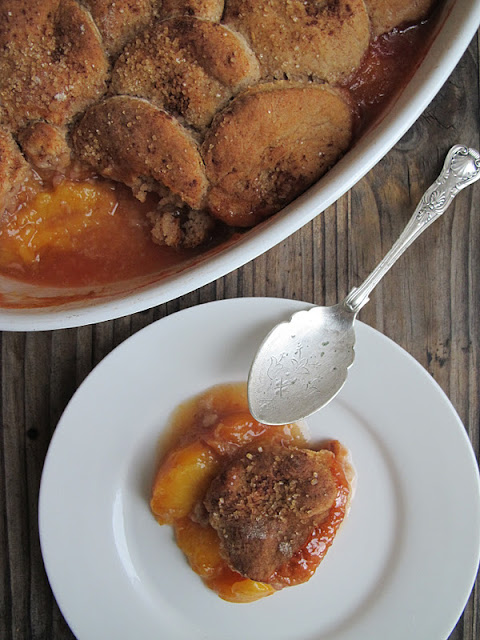Baking fruit in pies and crumbles is a wonderful way to serve deliciously ripe yet bruised and marred summer fruits.
So what about the Cobbler?
Cobblers originated in the American colonies when English settlers wanted their traditional, homely pies but needed to be more economical with precious ingredients like butter, suet and flour. Ingeniously they invented the cobbler: a pie without a dough base yet still yielding that pleasurable experience of breaking through flaky pie crust into the stewed fruit or meat treasures beneath.
Pondering this history, Washington Post food writer, Kim O'Donnel, suggested since the apple pie is English and the cobbler is American, perhaps the saying ought to be changed to “American as cobbler”.
The earliest written reference to a cobbler comes from 1839 in The Kentucky Housewife by Lettice Bryan:
“A Peach pot pie, or cobler, as it is often termed, should be made of clingstone peaches, that are very ripe, and then pared and sliced from the stones. Prepare a pot or oven with paste, as directed for the apple pot-pie, put in the prepared peaches, sprinkle on a large handful of brown sugar, pour in plenty of water to cook the peaches without burning them, though there should be but very little liquor or syrup when the pie is done. Put a paste over the top, and bake it with moderate heat, raising the lid occasionally, to see how it is baking. When the crust is brown, and the peaches very soft, invert the crust on a large dish, put the peaches evenly on, and grate loaf sugar thickly over it. Eat it warm or cold. Although it is not a fashionable pie for company, it is very excellent for family use, with cold sweet milk."
It’s fascinating to think they inverted the dish after cooking and served it with the pastry on the base. No wonder they thought the messy end result wasn’t fit for company!
It’s thought that the decorative placing of the crust into biscuit or dumpling shapes reminded people of either cobblestones or small cob loaves (which in turn were named for the cobblestones they themselves resembled). In fact, a cobbler’s rippled surface does look somewhat like a cobblestone street.
A thousand variations on the baseless pie exist across the US including the Crisp, Crumble, Betty, Grunt, Pandowdy, Slump, Buckle and Sonker.
Crisps and Crumbles have oatmeal in their tops; Grunts and Slumps are iron skillet stove-top cobblers from New England; Buckles combine the fruit with a yellow cake-like batter and bake them together; Pandowdies have their crust broken and stirred through the filling during baking; Sonkers are deep dish cobblers from North Carolina; and Brown Betties are layers of fruit and buttered breadcrumbs baked into a bread pudding consistency.
It is traditional that cobblers from the Deep South are made of single fruits, most popular being and blackberry, blueberry and peach, served with a scoop of vanilla ice cream.
Since peaches are synonymous with the American Deep South, it’s only fitting I fill this cobbler with slices of fresh, yellow peaches. You could peel them if you like, but once cooked the skin looses its horrid fuzziness and flushes the peach flesh with pretty pink hues. Given it’s easier, I recommend keeping them on.
Peach Cobbler
 Anna's very own recipe. Serves 8.
Anna's very own recipe. Serves 8.Ingredients:
Filling
1kg ripe juicy peaches, washed
¼ cup caster sugar
¼ cup water
¼ teaspoon cinnamon
1 tablespoon corn flour
Topping
150g (1 cup) self-raising flour*
30g brown sugar
1 teaspoon ground cinnamon
60g butter, coarsely chopped
½ teaspoon sea salt flakes
½ cup buttermilk, heavy cream or natural yoghurt
Milk, for brushing
½ teaspoon ground cinnamon, for dusting
1 tablespoon Demerara sugar, for dusting
Method:
1. Preheat oven to 190’C.
2. To make filling: cut each peach into eight slices and discard stones.
3. In a large pot, combine peaches, water and cinnamon then cover and simmer until peaches leach juices and start to bubble.
4. Add caster sugar, stir to combine then cover and simmer 3-5 minutes. Taste to ensure mixture is sweet enough. Add more sugar if needed.
5. Using a ladle, transfer a small amount of liquid to a bowl. Add cornflour and combine well.
6. Return cornflour liquid to peaches and stir through for a minute, then remove peaches from heat.
7. Pour peaches into an oven-proof baking dish. Spread evenly along base.
8. To make topping: process flour, brown sugar, cinnamon, butter and sea salt in a food processor until combined.
9. Add buttermilk, heavy cream or natural yoghurt (whichever you use) and process in short bursts until a dough forms.
10. Lightly flour hands and surface, then turn out dough and flatten.
11. Cut out shapes and place over peaches, overlapping.
12. Brush tops with milk, then sprinkle with cinnamon and Demerara sugar.
13. Bake for around 35 minutes or until has risen and turned golden.
Serve with good quality vanilla ice cream or heavy cream.
*Note: use wholemeal flour for extra depth of flavour.











































